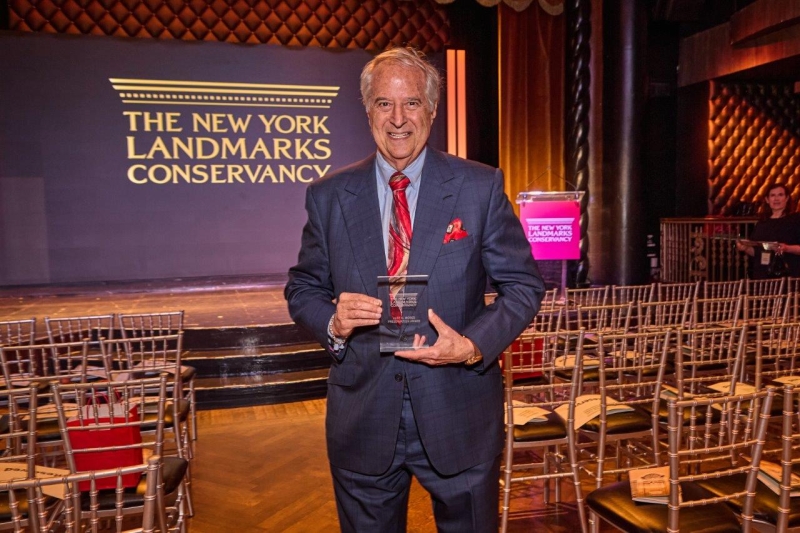Broadway’s Restoration Renaissance: Theater Owners Invest in Preservation and Progress
On April 22nd, at the Edison Ballroom, the New York Landmarks Conservancy honored some of the city’s most iconic Broadway theaters.
On April 22nd, at the Edison Ballroom, the New York Landmarks Conservancy honored some of the city’s most iconic Broadway theaters with its highest accolade—the Lucy G. Moses Preservation Award. This year’s ceremony spotlighted a significant trend: New York City theater owners are investing heavily in the restoration and modernization of their historic venues. This movement holds profound value for the theater industry and the city’s cultural and tourism economies. Among the restoration project honorees was the Palace Theatre.
Stewart F. Lane, co-owner of the Palace, accepted the award on behalf of himself and his partner James L. Nederlander. The Palace received the prize for a feat of engineering as ambitious as it was reverent. The 1913-built theater, an interior landmark, was carefully lifted 30 feet to make way for new development while maintaining every inch of its Gilded Age grandeur.
The project involved a meticulous four-month lift, supported by state-of-the-art engineering, preservation of plasterwork, and painstaking historical replication. The results are stunning: the Palace retains its ornate double balcony, cast-iron staircases, Siena marble, and lavish ceiling details, all while now offering expanded front-of-house space, enhanced accessibility, and improved safety systems. The Palace Theater is also the subject of a new book called It Happened At the Palace: A History of New York’s Iconic Broadway Theater, written by Stewart F. Lane with a foreword by James L. Nederlander.
A few blocks away, the Shubert and Booth Theatres—constructed initially between 1912 and 1913 by Lee and J.J. Shubert—also received the Lucy G. Moses Award, accepted by Keith Marston. Their joined facades along Shubert Alley underwent extensive restoration, most notably revealing and reviving a rare and long-concealed sgraffito plaster technique.
Layers of overpainting had muted these historic details; the restoration revealed original figurative elements and even uncovered a third pigment color that had been lost to time. Restorers brought these details back to life, deepening the visual richness of the twin facades and reconnecting audiences with the theaters’ original artistry.
%20accepting%20the%20award%20for%20the%20Booth%20and%20the%20Shubert%20Theaters%20.jpg)
At the New Victory Theater, Russell Granet of the New 42 accepted the preservation award for a project that protected one of Times Square’s oldest and most storied theaters. Opened in 1900 and reimagined in 1995 as Broadway’s premier venue for family-friendly performances, the New Victory faced a potential crisis when ornamental plaster from its dome threatened to fall.
What followed was a race against time: a 57-day, around-the-clock effort to reinforce the dome structurally, restore the putti that gaze down from its edges, and upgrade lighting within its ceiling—all while ensuring no disruption to the theater’s programming.
These Broadway venues were part of a broader slate of honorees at the 35th annual Lucy G. Moses Preservation Awards, which drew a sold-out crowd of 600 to celebrate preservation excellence across New York City. Seventeen remarkable projects were cited, ranging from co-op buildings and public housing to cultural landmarks like the Brooklyn Bridge.
In addition to the theater projects, awards were given to preservation efforts at 7 South Portland Avenue and 1450 Pacific Street in Brooklyn; the Edward Mooney House; the General Society of Mechanics & Tradesmen of the City of New York; the National Society of Colonial Dames in the State of New York; the New York Stock Exchange; the Powell Building; and the Brooklyn Bridge. Several New York City Housing Authority sites were also recognized, including the Exodus & Dance Frieze at Kingsborough Houses, Harlem River Houses, and the Nivola Horses at Stephen Wise Towers.
Susan Olsen was honored with the Preservation Leadership Award for her distinguished 22-year career at Woodlawn Cemetery, while Ann-Isabel Friedman, a long-standing preservationist and former director of the Conservancy's Sacred Sites program, received a Special Award for Preservation Service.
These ambitious restoration projects signal more than just an investment in bricks and plaster—they represent a deep commitment by New York City theater owners and cultural leaders to both heritage and innovation. By blending preservation with modern function, they ensure these iconic buildings remain relevant, accessible, and awe-inspiring for future generations.
For New York’s entertainment and tourism industries, the impact is equally profound. These landmark restorations strengthen the city’s identity as a global cultural capital. They attract visitors, drive economic activity, and enrich the theatergoing experience, ensuring that the magic of Broadway continues to dazzle, from sidewalk to spotlight.
For more information, see nylandmarks.org
%2C%20Russell%20Granet%20(New%2042)%2C%20Stewart%20F_%20Lane%20(%20Co-Owner%20of%20the%20Palace%20Theatre)%20.jpg)
(Co-Owner of the Palace Theatre)
Photos by James Salzano

Videos



%20accepting%20the%20award%20for%20The%20New%20Victory%20Theater.jpg)